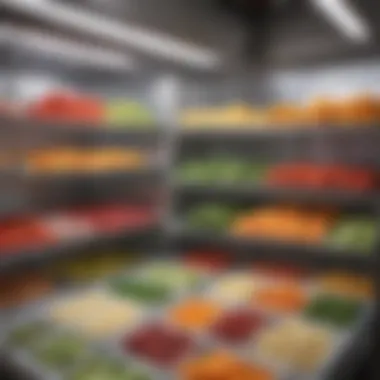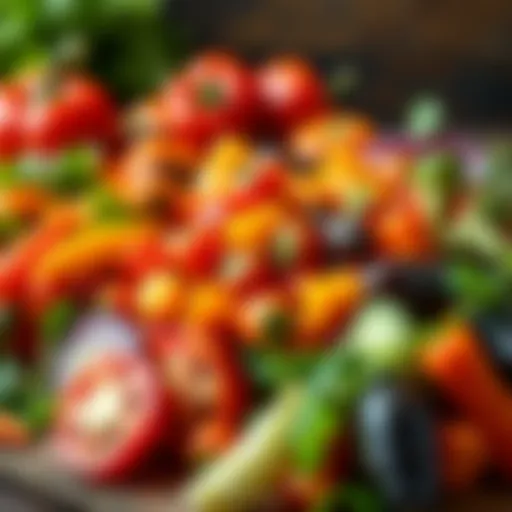Optimal Freezer Temperatures for Food Safety


Intro
Understanding the subtleties of freezer temperatures is more than just a culinary concern; it's a matter of food safety and quality. In this piece, we will unravel the essential guidelines that dictate the optimal freezing conditions. Not only does maintaining the right temperature help in preserving nutrients and flavors, but it also plays a crucial role in preventing foodborne illnesses.
So, why exactly is this topic paramount? When folks toss food into the freezer without a second thought, they might not realize that the temperature can make or break their dishes in the long run. Every item you put in there—from meats to veggies—demands distinct temperature considerations to ensure everything stays as delicious as it’s meant to be.
This guide will provide insights into standard temperature guidelines and will explore variations we should be aware of for different food types. By the end, you’ll be well-equipped to manage your freezer like a pro, ensuring that your culinary creations shine through even after the chill of the freezer. Get ready to dig deep into the frosty world of food preservation!
Understanding Freezer Temperature Standards
Freezer temperature standards form the backbone of food preservation. It's not simply a matter of setting a dial and forgetting about it. The importance of maintaining the right temperatures can't be overstated, as it directly impacts food safety and quality. Understanding the standards means you're not just a passive consumer but an active participant in your food's storage process.
The Ideal Freezing Temperature
Recommended settings
When it comes to recommended settings, most experts agree that a temperature of 0 degrees Fahrenheit (-18 degrees Celsius) is the gold standard for freezing food. This temperature ensures that the food remains frozen solid while inhibiting the growth of bacteria, preserving culinary integrity for much longer periods. The key characteristic of this setting is its ability to retain flavor, color, and nutritional value. This makes it a popular choice among home cooks striving for excellence in their meal prep.
One unique feature of maintaining this ideal temperature is its role in providing a consistent environment for various types of food, from meats to prepared meals. However, it’s important to consider that if the freezer is constantly opened, or if it’s overstuffed, temperature fluctuations can occur, affecting the overall quality of your food.
Impact on food texture and flavor
The impact of freezing temperatures on food texture and flavor is profound. Generally, when food is frozen at the correct temperature, cells remain intact, preventing the mushy texture that often plagues improperly frozen items. This is particularly evident when dealing with fruits and vegetables, which can suffer significantly from temperature abuse.
Furthermore, well-frozen food tends to retain its original flavor and aroma much better than poorly stored counterparts. This preservation is vital for anyone who values culinary nuances and desires to enjoy the full spectrum of tastes in their dishes. Nevertheless, if food is subjected to temperature fluctuations, there can be a notable decline in both texture and flavor, leading to potential disappointment at mealtime.
The Freezer's Role in Food Safety
Preventing bacterial growth
One of the primary functions of a freezer is its role in preventing bacterial growth. At temperatures below 32 degrees Fahrenheit (0 degrees Celsius), the growth of bacteria slows down considerably, effectively halting the deterioration of your food. This is particularly crucial for meats and dairy products, which are more susceptible to spoilage.
The key characteristic here is time; while meat stored at room temperature may spoil within hours, the same meat frozen properly can last for months, even years without significant risk of bacterial contamination. The trick is ensuring that the temperature is consistently low throughout the storage period. However, if the freezer fails or if there are frequent power outages, the risks associated with bacterial growth can escalate rapidly.
Understanding temperature danger zones
Understanding temperature danger zones is vital for any food enthusiast. Food is most vulnerable between 40 degrees F (4 degrees C) and 140 degrees F (60 degrees C). In this range, bacteria can multiply quickly, posing potential risks if food is stored improperly. Recognizing that your freezer's operating temperature shifts too far into this zone—even briefly—can lead to spoilage.
This knowledge empowers you to monitor your food storage practices actively. Don’t underestimate the importance of a good freezer thermometer. A device like that can save you from missteps in food safety, arming you with the knowledge to make well-informed choices about your food storage. The need for vigilance cannot be stressed enough, as any oversight can damage both taste and health.
Key Temperature Factors in Freezing
The significance of temperature in food freezing can’t be overstated. It stands at the heart of food preservation, ensuring that what you put in today remains safe and eatable tomorrow. If a freezer’s temperature fluctuates, the repercussions can be far-reaching, affecting everything from taste to the nutritional value of food. Thus, grasping the key temperature factors in this freezing game is essential for every food enthusiast.
Importance of Consistency
Thermal stability in food preservation
Achieving thermal stability is akin to hitting the sweet spot in your favorite recipe. It means your food remains at a constant temperature, which directly affects its preservation. When food stays uniformly frozen, it retains its flavor and texture when eventually cooked or eaten.
Maintaining this stability is not just beneficial; it is absolutely critical. A freezer operating at a steady -18°C (0°F) prevents ice crystals from growing large, ensuring that meat stays juicy and vegetables remain crisp.
Consistent temperatures in freezers not only preserve food but also save money in the long run by reducing waste.


However, thermal stability requires a good understanding of your freezer's operation. Some models may experience room for improvement in this area depending on how they are organized or how often you open the door. The unique challenge here lies in balancing frequent use and temperature maintenance.
How temperature fluctuations affect quality
Temperature fluctuations can wreak havoc on your food quality, much like a sudden storm ruining a sunny picnic. When food undergoes repeated cycles of freezing and thawing, it can lead to a compromised texture and altered flavors. Not to mention, it might invite some unwanted bacteria to the party.
Keeping your freezer door closed as much as possible is one solution to combat these pesky fluctuations. Added to that, organizing your foods in a way that minimizes the loss of cold air when the door opens can be a practical step.
Imagine a box of chocolates: every time you dip in, some might melt a little if the temperature changes too often. Thus, a well-organized freezer with consistent temperature settings preserves both quality and safety.
The Role of Different Freezer Types
Chest vs. upright freezers
The choice between a chest freezer and an upright one comes down to more than just aesthetics; it’s about function. Chest freezers, often more energy-efficient, hold cold air better when opened, which helps in keeping those stable temps. They tend to have more extensive storage space, allowing for bulk items, ideal for those who buy in volume.
On the flip side, upright freezers might win in terms of convenience. They come with shelves, which make it easier to organize various food items and grab what you need without rummaging through a mountain of frozen goods. But they can lose cold air quickly when the door is opened.
So, it's like choosing between a cozy blanket and a stylish jacket. Each has its perks and drawbacks, depending on your specific needs and storage habits.
Commercial versus domestic models
Commercial freezers are typically built to withstand heavier use and are optimized for maintaining low temperatures under high demands. They might not be necessary for an average home, but for those running a bustling kitchen, they spell efficiency and reliability.
Domestic models, on the other hand, focus more on versatility and user-friendly features. They come packed with convenience options that make everyday use more manageable for the typical household. However, under heavy usage, they might not perform as consistently as their commercial counterparts.
In essence, the right choice hinges on your needs and how you intend to store food. Understanding the difference can make all the difference in food safety and quality.
Recommended Storage Temperatures for Various Foods
When it comes to freezing food, understanding the recommended storage temperatures for various items is absolutely crucial. Freezing food at the right temperature ensures that not only does it stay fresh longer, but it also retains its original flavor and texture. Certain foods have specific needs when it comes to freezing, and knowing these can safeguard against spoilage and even potential foodborne illnesses. By adhering to established guidelines, you can significantly enhance your meal prep and make the most of what you've got in the freezer.
Meats and Poultry
Optimal settings for red meat
When freezing red meat, typically, the ideal temperature to set your freezer is around -18 degrees Celsius (0 degrees Fahrenheit). This particular temperature is important because it prevents the growth of bacteria that can cause spoilage. One of the standout features of freezing red meat at this temperature is that it helps maintain its juiciness and flavor. When you freeze at the recommended setting, the process slows down degradation. While you can freeze red meat for up to six months, proper wrapping can lessen the chance of freezer burn, which can lead to unpleasant textures and flavors. Avoid re-freezing defrosted meat unless cooked, as this can compromise its safety.
Freezing guidelines for poultry
Poultry, much like red meat, requires careful attention when storing in the freezer. The optimal freezing temperature for poultry should ideally also be around -18 degrees Celsius (0 degrees Fahrenheit). One key characteristic that makes this temperature recommendation popular is that it effectively retains the moisture content of the meat, keeping it succulent even after thawing. However, unlike red meat, poultry should ideally be frozen in smaller portions for quicker freezing and even thawing. A notable advantage of freezing poultry correctly is it can last up to a year if stored properly, just make sure to remove excess air to prevent freezer burn. Always cook poultry thoroughly before consuming after thawing, ensuring all bacteria are eliminated.
Vegetables and Fruits
Freezing techniques for vegetables
Vegetables require a touch more finesse when it comes to freezing. Most veggies need to be blanched before freezing; this means briefly boiling them, then immediately cooling them in ice water. The importance of this technique lies in preserving their color, texture, and nutritional value. Blanching disrupts enzymes that can lead to spoilage, meaning your green beans or broccoli can look and taste as close to fresh as possible even after months in the freezer. Set the freezer at that -18 degrees Celsius mark, and your veggies can last up to a year. But make sure you have air-tight containers or bags; this is key for preventing freezer burn that can spoil your efforts.
Best practices for fruit storage
Despite fruits having a different structure, they still benefit greatly from optimal freezer storage. Among the best practices for fruit storage is to choose ripe fruit and wash it well before freezing. This ensures that dirt and pesticides are removed. Although fruit doesn’t need blanching, having them cut into smaller pieces does help with quicker freezing and easier use later. Maintaining that constant -18 degrees Celsius ensures fruits like berries or bananas maintain their sweetness and flavor. A unique feature about freezing fruits is that you can actually enhance some flavors; for instance, freezing mango can intensify its natural sweetness. Just know that while fruits can stay good for a year in the freezer, once thawed, they don’t have quite the same texture, so plan on using them in smoothies or baking.
Prepared Meals and Leftovers


Safe freezing of cooked dishes
Freezing cooked meals rightly benefits not just flavor but also convenience for later use. To keep cooked dishes safe in the freezer, they should be cooled down to room temperature before packing them away. One key characteristic is that cooked foods should also be portioned into individual s, allowing you to thaw only what you need. Pack them in sealable bags or air-tight containers to delay freezer burn and maintain quality. Properly frozen cooked meals can last between two to six months, making weeknight dinners a breeze. A disadvantage is that certain textures might change, for instance, cream-based sauces can separate when reheating, but that can often be remedied by whisking them well.
Reheating and quality retention
Reheating previously frozen meals adds another dimension to food management. When it comes to quality retention during reheating, the method of thawing is crucial. Slow thawing in the fridge retains more moisture and flavor compared to rapid methods. One key characteristic here is that while microwave thawing might save time, it can lead to uneven temperatures, compromising food safety. Aim to plate and reheat frozen meals either in an oven or saucepan for best results, ensuring that they reach a safe temperature of 75 degrees Celsius (165 degrees Fahrenheit). While this method does require patience, the reward is richly flavorful meals without losing the essence of what you've prepared.
Best Practices for Managing Freezer Temperature
Maintaining the right freezer temperature is not just a tick in the box, it’s essential for ensuring your food remains safe and tasty. Understanding how to manage these temperatures effectively can significantly impact the shelf life and quality of stored foods. A few small yet crucial practices can make all the difference. Here we’ll delve into best practices that will help you keep your freezer running smoothly and your food safe.
Regular Temperature Checks
Using thermometers effectively
Using thermometers in your freezer may seem like a straightforward task, but it holds a significant role in food preservation. A reliable thermometer gives you a clear picture of how cold your freezer is, allowing for accurate monitoring of the temperature. Regular checks, ideally on a weekly basis, ensure that your appliance is not too warm or too cold, thus preventing compromise on food quality.
When using thermometers, look for those that can be easily read from the outside and have a temperature range suitable for freezers. Digital thermometers tend to be a popular choice due to their precision. However, some traditional dial thermometers might work quite fine too. A unique feature of these tools is the ability to provide instant feedback, allowing you to make adjustments right away if temperatures are not where they should be. Without this insight, your food might be sitting in a danger zone, leading to spoilage or waste.
Indicators of malfunctioning freezers
Recognizing indicators of malfunctioning freezers is crucial for maintaining food safety. If your freezer is struggling to keep consistent temperatures, there are a few signs to watch for. These include frost build-up in unusual places, like on the door seals or around the edges of the shelves, or if the freezer is louder than normal. Such indicators suggest that something might be off with the cooling mechanism.
A functional freezer should operate quietly, with only the soft sounds of the motor. When these indicators pop up, they can signal impending failure which could lead to food safety issues. Ignoring these warning signs can be a slippery slope—ultimately leading to wasted food and money. Addressing these concerns quickly can save your freezer and your groceries from potential disasters.
Organizational Strategies
Best shelving techniques
The way you organize your freezer can directly affect its efficiency and the temperature control within it. Optimal shelving techniques involve a few simple yet effective strategies. Ensure that air can circulate freely around the foods. This means not overcrowding shelves and leaving space between items to avoid hot spots.
For instance, placing bulky items like turkeys or large containers at the back or bottom can prevent cold air from circulating effectively. Instead, opt for shallow containers at the front that offer easier access to often-used items without the need to dig deep. Good organization helps reduce temperature fluctuations every time you open the door, making it a top-notch practice for maintaining ideal freezer conditions.
How to avoid temperature loss
To avoid temperature loss, there are strategies that go beyond mere organization. Always check the seals on the freezer door to ensure they’re working properly. If the seals are worn out or loose, cold air can escape, leading to higher running costs and fluctuating temperatures.
Another tactic is to keep your freezer as full as possible without overpacking. A fuller freezer retains cold better than an empty one because the mass of frozen food helps to maintain a stable temperature. If your freezer is typically underutilized, consider adding ice packs or water bottles to maintain cold air when you open the door. This small adjustment can dramatically assist in holding the temperature down, ensuring that your food stays frozen and safe for longer.
"A well-managed freezer not only keeps food safe but also preserves flavor—it's a win-win!"
Implementing these simple practices can end up paying huge dividends in food safety and quality. With these strategies at your fingertips, you’ll find that managing your freezer temperature can be a smooth sleigh ride instead of a bumpy journey.
Understanding Freezer Myths and Misconceptions
When diving into the realm of food storage, it's essential to peel back the layers of common myths and misconceptions regarding freezers. These misunderstandings can lead to practices that jeopardize food safety and quality. Understanding freezer truths can make a world of difference for food lovers keen on preserving their ingredients and meals effectively. By addressing these myths, we arm ourselves with knowledge that ensures healthier eating habits and reduces waste.
Misunderstandings About Temperature Settings
Common beliefs debunked
One of the most popular misconceptions is that all freezers should be set to the same temperature. Many think that if food is frozen solid, it's safe. However, that’s a half-truth. The reality is that freezers operate best at a standard temperature of 0°F (-18°C). Setting the temperature colder might not offer an additional advantage, and can actually affect power consumption—nobody wants to run up their energy bills without clear benefits.


In this article, we will dig deep into why a consistent standard is not only advantageous but necessary for proper food storage practices. Misunderstandings can easily lead to unsafe food practices, impacting our health and waste.
Impact of myths on food safety practices
Misconceptions also extend to food safety practices. For instance, there’s a myth that as long as food is frozen, it’s safe indefinitely. This isn’t entirely correct. While freezing does slow down the growth of microorganisms, it doesn't kill them. Some pathogens can linger even in a frozen state, waiting for a warm-up to resume their malicious activities. The impact of these myths can lead consumers to make ill-informed choices that might compromise their health. Proper education on how long different foods can stay frozen—while maintaining their safety—is vital.
Freezing and Nutritional Value
Shelf life vs. nutritional integrity
There is often confusion surrounding the concept of shelf life versus nutritional integrity. A common belief is that food perfectly maintains its nutrition until the very last day of its so-called shelf life. In truth, while food may remain safe to eat, nutritional value can degrade over time, even in the cold embrace of a freezer.
For example, vitamin C and some B vitamins break down more rapidly than you might think when food is frozen. Delving into these facts helps consumers make informed choices about how frozen foods should fit into their diet without sacrificing health.
Importance of freezing methods
The way food is frozen can greatly affect both safety and taste. Some believe throwing food in the freezer is a catch-all solution. However, methods matter. For instance, flash freezing is one method that preserves the quality and nutrients much better than simply placing it into a regular freezer. Understanding these methods and their implications will shed light on how to maximize the benefits of freezing for both culinary pleasure and health.
In summary, unmasking these myths isn’t just an academic exercise; it’s about empowering ourselves as food enthusiasts. With the right knowledge, we can preserve, enjoy, and maximize the benefits of our food, ensuring safety and taste in every bite.
Future Trends in Freezer Technology
As we look ahead, it is crucial to understand how advancements in freezer technology are reshaping food storage and safety. These innovations not only improve efficiency but also address the growing concerns about energy consumption and food wasted. By adopting new technologies, consumers are becoming more adept at managing their food supply while ensuring its safety and quality.
Smart Freezer Innovations
Integration with smart home systems
Integrating freezers with smart home systems represents a significant leap in kitchen technology. This connection allows users to control their freezers remotely, which is especially valuable for those who live busy lives and may forget to adjust temperatures during peak usage times. Such integration also adds convenience, enabling alerts to be sent to phones when temperatures fluctuate, potentially signaling a malfunction.
One of the standout characteristics of this integration is its user-friendly application. By using an accompanying app, users can monitor their freezer health, check the internal temperature, and even get reminders about when to check food items. This technology aligns well with the goal of enhancing food safety and automation in the kitchen.
However, it's important to note that reliance on technology has its drawbacks. Technological glitches can occur, causing false alarms, which may lead to unnecessary anxiety or wasted food if not addressed promptly. But overall, the benefits in convenience and proactive food management are significant.
Benefits of automated temperature monitoring
Automated temperature monitoring is an essential component of modern freezers that greatly contributes to food safety. This system continuously tracks freezer temperatures and sends alerts if the settings go awry, which can happen due to power outages or equipment failures. By maintaining optimal temperatures, food quality is preserved, minimizing the risk of spoilage or freezer burn.
A key characteristic of this feature is its ability to provide real-time data, which helps users make informed decisions about their stored items. For instance, users can instantly know if any adjustments should be made based on sudden temperature changes. This direct feedback is not just beneficial; it creates a comprehensive layer of safety for food preservation.
On the downside, such sophisticated systems may come with a higher initial cost. Some users may hesitate to invest in automated solutions when traditional freezers still provide essential services. Yet, as education around food safety impacts daily living, these technologically advanced systems might soon become the norm rather than the exception.
Energy Efficiency Enhancements
Latest advancements in energy-saving technology
The advancements in energy-saving technology inside modern freezers cannot be overstated. These enhancements focus on minimizing energy consumption while ensuring foods are stored under ideal conditions. Many new models use advanced insulation materials and eco-friendly refrigeration systems that consume significantly less power than older designs.
One notable characteristic of these technologies is their smart energy modes, which allow freezers to adjust their energy usage based on the current load and user needs. For example, during periods of inactivity, the freezer might enter a low-energy state, allowing for savings without compromising the food stored inside.
The tradeoff, however, can be the high upfront cost associated with purchasing these energy-efficient models. Yet, more consumers are viewing them as valuable investments, leading to long-term savings on energy bills and reducing their carbon footprint.
Environmental considerations for modern freezers
Today's consumers are increasingly concerned about the environmental impact of their appliances, making it imperative for freezer manufacturers to focus on sustainability. Modern freezers are designed with greener materials and processes, such as using refrigerants with less potential to deplete the ozone layer. This shift reflects a growing commitment within the industry to produce appliances that are kinder to the planet.
A notable characteristic is the trend towards recyclable and biodegradable materials in freezer construction, reducing landfill waste. Consumers are looking for ways to decrease their ecological footprint, which makes products with a sustainability angle more appealing.
But this also brings challenges regarding technology durability and potential cost implications. Some eco-friendly materials may not match the long-lasting nature of traditional components. Balancing sustainability with durability is a challenge that manufacturers continue to navigate, but the drive toward a more eco-conscious market is undeniably shaping the future of freezers.
"The future of freezer technology is not just about keeping things frozen, it’s about how to do it sustainably and smartly."







